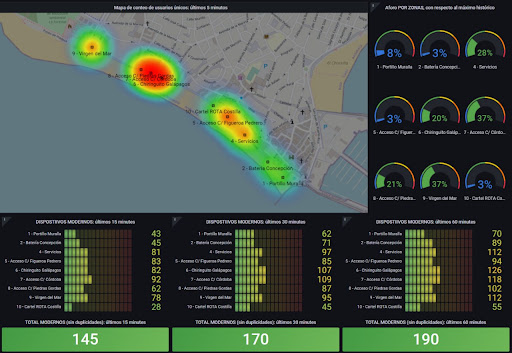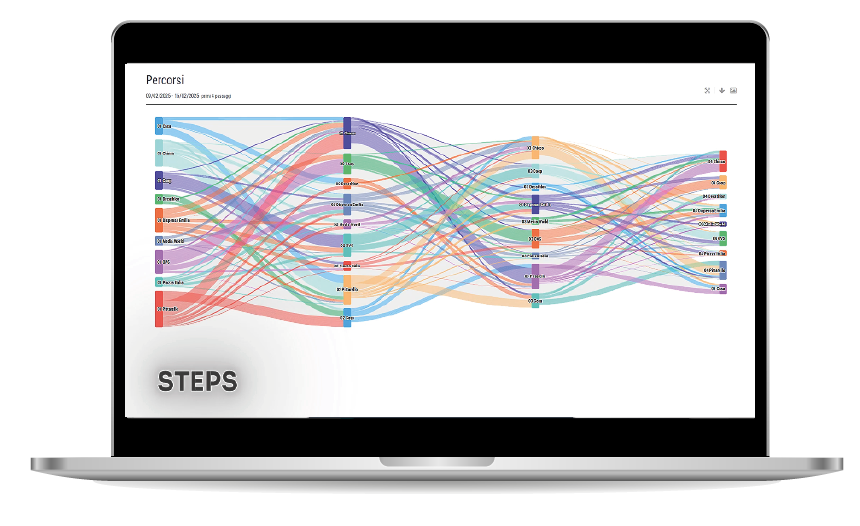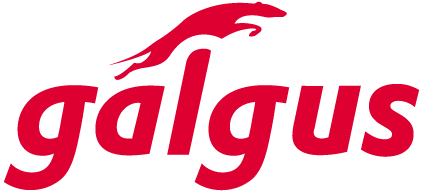In an increasingly urban and digitalized world, smart cities are transforming the way we manage public services, mobility, and security, with the aim of improving the quality of life for residents and visitors.
The connected city is the cornerstone of this evolution: an environment where communications infrastructure and real-time data enable more agile, efficient, and user-centric decision-making.
Galgus combines AI-powered Wi-Fi with location and presence analytics, offering a comprehensive solution to improve the experience of citizens and tourists, optimize public resources, and ensure safer and friendlier environments.
The main challenges of modern cities
Today’s cities face complex challenges stemming from high population density, the growing demand for digital services, and the tourism boom. These challenges make urban planning and the provision of optimal infrastructure difficult.
- Congestion and infrastructure saturation: High user density in public spaces causes performance drops in communications networks and bottlenecks in transportation.
- Lack of real-time visibility: Without reliable data on people flows and facility use, municipal planning is carried out with insufficient information.
- Security and crowd control: Large gatherings of people at mass events require early detection of incidents and rapid response.
What does Galgus provide to overcome them?
Galgus offers solutions that integrate intelligent connectivity and advanced analytics, transforming each Wi-Fi access point into an active sensor for monitoring and managing the urban environment.
AI-powered Wi-Fi
Galgus’ CHT technology enables access points to act collaboratively to:
- Proactive load balancing before congestion.
- Smart roaming for seamless transitions.
- Dynamic channel and power allocation to maximize coverage and performance.
- Traffic control by user or group to ensure a deterministic experience.
- Smart preset that initially distributes clients to the optimal AP.
These capabilities deliver high performance in extremely dense environments, reduce infrastructure costs, and scale without manual intervention.
Location and presence analytics

Over the same Wi-Fi network, Galgus incorporates location and presence analytics to measure flows, densities, and movement patterns, providing key information for decision-making.
- Detect and count connected and unconnected devices with high accuracy, thanks to the fingerprint constructed from probing frames.
- Generate heat maps and identify traffic flows to identify critical areas and preferred routes in real time.
- Follow users’ journeys, showing sequences of passages through different spaces.
- Issue early warnings of density anomalies or unusual movements.
- Ensure privacy through edge anonymization and aggregated data in compliance with GDPR.
Concrete benefits of Galgus solutions for connected cities
The integration of these technologies translates into tangible benefits for citizens, municipal managers, and security forces.
Improved experience for citizens and tourists
By offering stable connectivity and real-time location analytics, we facilitate access to digital services and guide visitors to balance flows and discover new areas.
- Omnipresent connectivity in plazas, parks, and museums, facilitating seamless access to digital services and communications.
- Intelligent guidance with route suggestions to less crowded attractions, balancing visitor flows.
- Personalized services, such as offers and notifications at points of interest (local promotions, transportation schedules, or service signage).
Resource management and optimization

Real-time data analytics transforms the management of public services, enabling much more dynamic and efficient resource allocation.
Instead of operating with static schedules, city managers can adjust service provision based on actual demand and infrastructure usage patterns.
- Dynamic resource allocation: The ability to measure the flow and density of people in different areas allows for adapting public service delivery in real time, ensuring that resources are deployed where and when they are most needed.
- Predictive maintenance: Analyzing historical data and usage trends makes it easier to anticipate peak demand or infrastructure wear and tear. This allows for proactive maintenance tasks to be scheduled, preventing failures and optimizing asset lifespans.
- Operational efficiency: By understanding how spaces and services are used, it’s possible to make informed decisions that lead to greater efficiency and significant savings in operating costs, while ensuring high quality of service.
Public safety
Galgus solutions improve urban security through real-time analysis and data integration, enabling municipal officials and law enforcement agencies to anticipate and react effectively to any incident.
- Proactive incident detection: Flow and density analysis identifies areas with unusual behavior, unauthorized presence, or critical crowding, generating automatic alerts for immediate resource deployment.
- Emergency coordination: With geolocated data on people and devices, control centers optimize evacuation routes and the positioning of emergency vehicles and patrols, reducing response times.
- Crime reduction: Understanding movement patterns helps plan police presence in hot spots and implement patrol strategies.
The connected city is a tangible reality that redefines urban management. With Galgus, municipalities can make decisions based on real data, improve the citizen and visitor experience, optimize operating costs, and increase citizen safety.
If you’d like to know how we make this possible, here are several success stories, such as the Santa Cruz neighborhood of Seville or the Colombian city of La Dorada.









